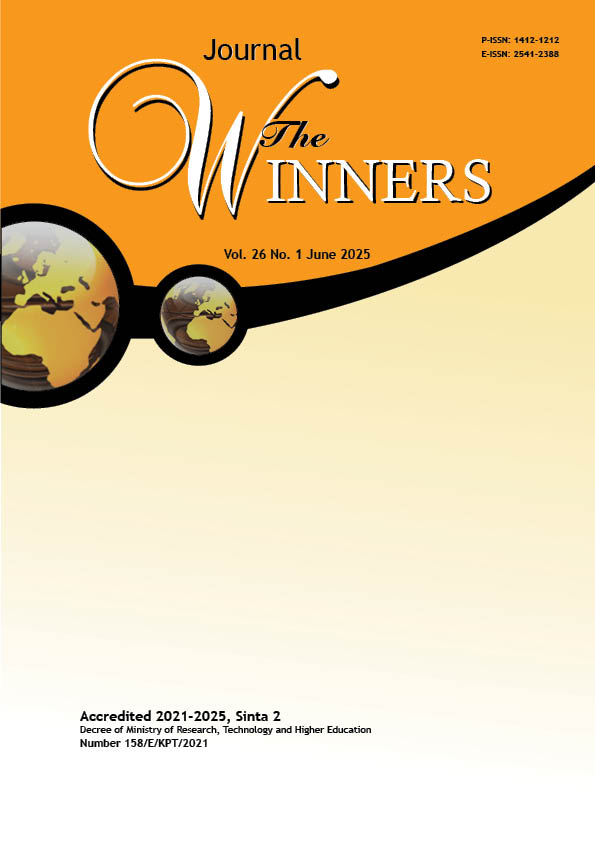The Influence of Mobile Banking Attributes on Cashless Society through Adaptive Anthropomorphism and Task-Fit Technology
DOI:
https://doi.org/10.21512/tw.v26i1.12717Keywords:
UTAUT Model, cashless society, adaptive anthropomorphism, task-fit technologyAbstract
The research aimed to analyze the role of adaptive anthropomorphism and Task-Fit Technology (TFT) in mediating the relationship between performance expectancy, effort expectancy, perceived security, and a cashless society among traditional market traders. The research procedures applied a quantitative design, and the sample population consisted of 279 traditional market traders who had utilized mobile banking services. The data obtained were analyzed using Partial Least Squares Structural Equation Modeling (PLS-SEM) to measure the structural relationships. Smart-PLS 3 was utilized as the analytical tool, following a two-stage process to examine data and assess the influence and significance of mediating variables. The results show the benefits of integrating Mobile Banking with the Unified Theory of Acceptance and Use of Technology (UTAUT) and Task-Fit Technology (TFT), offering scientific explanations and empirical evidence based on customer experiences in financial transactions. Adaptive anthropomorphism serves as a mediating factor, bridging the relationship between facilitating conditions, perceived security, perceived trust, and the adoption of a cashless society. In addition, TFT mediates the connection between effort expectancy, perceived security, perceived trust, and the adoption of a cashless society within the context of mobile banking services. These results could be helpful for banking management because facilitating conditions positively encourages the use of non-cash payments in the market between merchants and consumers where proof of payment is represented through human-like voice interaction.
References
Afeti, E. Y., & Owusu, A. (2022). Impact of mobile payments on micro-business activities: A Developing country experience . In R. Boateng, S. L. Boateng, T. Anning-Dorson, L. Olumide Babatope (Eds.), Digital innovations, business and society in Africa (pp. 75-95). Springer, Cham.
Alalwan, A. A., Dwivedi, Y. K., Rana, N. P., & Algharabat, R. (2018). Examining factors influencing Jordanian customers’ intentions and adoption of internet banking: Extending UTAUT2 with risk. Journal of Retailing and Consumer Services, 40, 125-138. https://doi.org/10.1016/j.jretconser.2017.08.026.
Almaiah, M. A., Al-Otaibi, S., Shishakly, R., Hassan, L., Lutfi, A., Alrawad, M., Qatawneh, M., & Alghanam, O. A. (2023). Investigating the role of perceived risk, perceived security and perceived trust on smart m-banking application using SEM. Sustainability (Switzerland), 15(13), 9908. https://doi.org/10.3390/su15139908.
Aman, I., Yuvita, Y., & Hafd, A. (2023). Efektivitas penggunaan quick response Indonesia standard (QRIS) di pasar tradisional Pabaeng-Baeng Kota Makassar. eCo-Buss, 6(2), 870-881. https://doi.org/10.32877/eb.v6i2.1052.
Arcand, M., PromTep, S., Brun, I., & Rajaobelina, L. (2017). Mobile banking service quality and customer relationships. International Journal of Bank Marketing, 35(7), 1068-1089. https://doi.org/10.1108/IJBM-10-2015-0150.
Azis, I. J. (2024). Listen and design: On micro, small and medium enterprises. Springer.
Baabdullah, A. M., Alalwan, A. A., Rana, N. P., Kizgin, H., & Patil, P. (2019). Consumer use of mobile banking (M-Banking) in Saudi Arabia: Towards an integrated model. International Journal of Information Management, 44, 38-52. https://doi.org/10.1016/j.ijinfomgt.2018.09.002.
Baptista, G., & Oliveira, T. (2015). Understanding mobile banking: The unified theory of acceptance and use of technology combined with cultural moderators. Computers in Human Behavior, 50, 418-430. https://doi.org/10.1016/j.chb.2015.04.024.
Changchun, G., Haider, M., & Akram, T. (2017). Investigation of the effects of task technology fit, attitude and trust on intention to adopt mobile banking: Placing the mediating role of trialability. International Business Research, 10(4), 77-91. https://doi.org/10.5539/ibr.v10n4p77.
Che, M., Say, S. Y. A., Yu, H., Zhou, Q., Shu, J., Sun, W., Luo, X., & Xu, H. (2023). Investigating customers’ continuous trust towards mobile banking apps. Humanities and Social Sciences Communications, 10. https://doi.org/10.1057/s41599-023-02483-3.
Chi, O. H., Jia, S., Li, Y., & Gursoy, D. (2021). Developing a formative scale to measure consumers’ trust toward interaction with artificially intelligent (AI) social robots in service delivery. Computers in Human Behavior, 118, 106700. https://doi.org/10.1016/j.chb.2021.106700
Chin, W. W. (1998). Commentary: Issues and Opinion on Structural Equation Modeling. MIS Quarterly, 22(1), 7-16.
Chiu, J. L., Bool, N. C., & Chiu, C. L. (2017). Challenges and factors influencing initial trust and behavioral intention to use mobile banking services in the Philippines. Asia Pacific Journal of Innovation and Entrepreneurship, 11(2), 246-278. https://doi.org/10.1108/apjie-08-2017-029.
Dahlberg, T., Guo, J., & Ondrus, J. (2015). A critical review of mobile payment research. Electronic Commerce Research and Applications, 14(5), 265-284. https://doi.org/10.1016/j.elerap.2015.07.006.
de Andrés-Sánchez, J., & Gené-Albesa, J. (2023). Assessing attitude and behavioral intention toward chatbots in an insurance setting: A mixed method approach. International Journal of Human–Computer Interaction, 40(17), 4918-4933. https://doi.org/10.1080/10447318.2023.2227833.
de Kloet, M., & Yang, S. (2022). The effects of anthropomorphism and multimodal biometric authentication on the user experience of voice intelligence. Frontiers in Artificial Intelligence, 5. https://doi.org/10.3389/frai.2022.831046.
Eneizan, B., Mohammed, A. G., Alnoor, A., Alabboodi, A. S., & Enaizan, O. (2019). Customer acceptance of mobile marketing in Jordan: An extended UTAUT2 model with trust and risk factors. International Journal of Engineering Business Management, 11. https://doi.org/10.1177/1847979019889484.
Ferghyna, Rachmadi, A., & Herlambang, A. D. (2020). Pengaruh facilitating conditions dan behavioral intention terhadap use behavior pada pengguna aplikasi BNI mobile banking. Jurnal Pengembangan Teknologi Informasi Dan Ilmu Komputer, 4(9), 3201-3208.
Fornell, C., & Larcker, D. F. (1981). Evaluating structural equation models with unobservable variables and measurement error. Journal of Marketing Research, 18(1), 39-50.
Geebren, A., Jabbar, A., & Luo, M. (2021). Examining the role of consumer satisfaction within mobile eco-systems: Evidence from mobile banking services. Computers in Human Behavior, 114, 106584. https://doi.org/10.1016/j.chb.2020.106584
Guo, J., & Bouwman, H. (2016). An analytical framework for an m-payment ecosystem: A merchants׳ perspective. Telecommunications Policy, 40(2-3), 147-167. https://doi.org/10.1016/j.telpol.2015.09.008.
Gupta, S., & Dhingra, S. (2022). Modeling the key factors influencing the adoption of mobile financial services: An interpretive structural modeling approach. Journal of Financial Services Marketing, 27(2), 96-110. https://doi.org/10.1057/s41264-021-00101-4.
Hair Jr, J. F., Hult, G. T. M., Ringle, C. M., Sarstedt, M., Danks, N. P., Ray, S., Hair, J. F., Hult, G. T. M., Ringle, C. M., & Sarstedt, M. (2021). Partial Least Squares Structural Equation Modeling (PLS-SEM) using R: A workbook. Springer Nature.
Hair Jr, J. F., Matthews, L. M., Matthews, R. L., & Sarstedt, M. (2017). PLS-SEM or CB-SEM: Updated guidelines on which method to use. International Journal of Multivariate Data Analysis, 1(2), 107-123. https://doi.org/10.1504/IJMDA.2017.087624.
Jamshidi, D., Keshavarz, Y., Kazemi, F., & Mohammadian, M. (2018). Mobile banking behavior and flow experience: An integration of utilitarian features, hedonic features and trust. International Journal of Social Economics, 45(1), 57-81. https://doi.org/10.1108/IJSE-10-2016-0283.
Kaur, S., & Arora, S. (2021). Role of perceived risk in online banking and its impact on behavioral intention: Trust as a moderator. Journal of Asia Business Studies, 15(1), 1-30. https://doi.org/10.1108/JABS-08-2019-0252.
Komulainen, H., & Saraniemi, S. (2019). Customer centricity in mobile banking: A customer experience perspective. International Journal of Bank Marketing, 37(5), 1082-1102. https://doi.org/10.1108/IJBM-11-2017-0245.
Kosim, K. P., & Legowo, N. (2021). Factors affecting consumer intention on QR payment of mobile banking: A case study in Indonesia. Journal of Asian Finance, Economics and Business, 8(5), 391-401. https://doi.org/10.13106/jafeb.2021.vol8.no5.0391.
Kurniawan, M., Restianita, O., & Normasyhuri, K. (2024). Perceived usefulness , perceived enjoyment, trust dan continuance intention dalam mobile sharia banking : Bagaimana kekuatan kepuasan nasabah? INOVASI: Jurnal Ekonomi, Keuangan, dan Manajemen, 20(3), 640-657.
Kusuma, M. W. (2023). Pedagang di pasar Anyar Singaraja kuasai 3-12 kios. DetikNews. https://www.detik.com/bali/berita/d-6554801/pedagang-di-pasar-anyar-singaraja-kuasai-3-12-kios.
Laukkanen, T. (2016). Consumer adoption versus rejection decisions in seemingly similar service innovations: The case of the Internet and mobile banking. Journal of Business Research, 69(7), 2432-2439. https://doi.org/10.1016/j.jbusres.2016.01.013.
Lee, J.-C., & Chen, X. (2022). Exploring users’ adoption intentions in the evolution of artificial intelligence mobile banking applications: The intelligent and anthropomorphism perspectives. International Journal of Bank Marketing, 40(4), 631-658. https://doi.org/10.1108/IJBM-08-2021-0394.
Lesmana, R. A, & Ashfath, F. (2022). Analisis pengaruh performance expectancy dan effort expectancy terhadap minat penggunaan aplikasi Jago milik PT.Bank Jago Tbk. In Seminar Nasional Akuntansi dan Manajemen Politeknik Negeri Jakarta (SNAM PNJ) (Vol.3).
Lestari, D., Darma, D., & Muliadi, M. (2020). Fintech and micro, small and medium enterprises development: Special reference to Indonesia. Entrepreneurship Review, 1(1), 1-9.
Lyu, V. C., Chin, W., Zhang, H., & Liu, V. (2022). Value added or overload? A study of the countervailing effects of non‐core features on mobile banking apps. Journal of Consumer Behaviour, 21(3), 602-613. https://doi.org/10.1002/cb.2003.
Mahfuz, M. A., Khanam, L., & Wang, H. (2017). The influence of culture on m-banking technology adoption: An integrative approaches of UTAUT2 and ITM. In 2016 Portland International Conference on Management of Engineering and Technology (PICMET) (pp. 824–835). IEEE. https://doi.org/10.1109/PICMET.2016.7806814.
Manser Payne, E. H., Peltier, J., & Barger, V. A. (2021). Enhancing the value co-creation process: Artificial intelligence and mobile banking service platforms. Journal of Research in Interactive Marketing, 15(1), 68-85. https://doi.org/10.1108/JRIM-10-2020-0214.
Marciano, L. L., Chandra, M., & Iskandar, V. (2022). Analisis penerapan model UTAUT terhadap minat beli pada Sayurbox. Jurnal Manajemen Perhotelan, 8(2), 80-91.
Maurida, I., Hanna, S. R., & Yuwana, S. I. P. (2024). Optimalisasi Pasar Tradisional Dalam Meningkatkan Minat Pengunjung Di Pasar Tanjung Kabupaten Jember. Khidmah: Jurnal Pengabdian Masyarakat, 2(1), 13-25.
McLean, G., Osei-Frimpong, K., Al-Nabhani, K., & Marriott, H. (2020). Examining consumer attitudes towards retailers’m-commerce mobile applications–An initial adoption vs. Continuous use perspective. Journal of Business Research, 106, 139-157. https://doi.org/10.1016/j.jbusres.2019.08.032.
Migliore, G., Wagner, R., Cechella, F. S., & Liébana-Cabanillas, F. (2022). Antecedents to the adoption of mobile payment in China and Italy: An integration of UTAUT2 and innovation resistance theory. Information Systems Frontiers, 24(6), 2099-2122. https://doi.org/10.1007/s10796-021-10237-2.
Moghavvemi, S., Mei, T. X., Phoong, S. W., & Phoong, S. Y. (2021). Drivers and barriers of mobile payment adoption: Malaysian merchants’ perspective. Journal of Retailing and Consumer Services, 59, 102364. https://doi.org/10.1016/j.jretconser.2020.102364.
Molina-Collado, A., Salgado-Sequeiros, J., Gómez-Rico, M., Aranda García, E., & De Maeyer, P. (2021). Key themes in consumer financial services research from 2000 to 2020: A bibliometric and science mapping analysis. International Journal of Bank Marketing, 39(7), 1446-1478. https://doi.org/10.1108/IJBM-01-2021-0043.
Moriuchi, E. (2021). An empirical study on anthropomorphism and engagement with disembodied AIs and consumers’ re-use behavior. Psychology and Marketing, 38(1), 21-42. https://doi.org/10.1002/mar.21407.
Ningsih, A., & Hamid, R. S. (2022). peran effort expectancy facilitating conditions price value dalam menentukan behavioural intentions pada nasabah pengguna mobile banking. Owner: Riset Dan Jurnal Akuntansi, 7(1), 322-332. https://doi.org/10.33395/owner.v7i1.1263.
Njenga, A. K., Litondo, K., & Omwansa, T. (2016). A theoretical review of mobile commerce success determinants. Journal of Information Engineering and Applications, 6(5), 13-23.
Nubatonis, J. P. S., Ballo, F. W., & Kiak, N. T. (2024). Implementasi Quick Response Code Indonesian Standard (QRIS) Untuk Pelaku Usaha Di Pasar Tradisional: Studi Kasus Pada Pasar Tradisional Di Kota Kupang. Jurnal Ekonomi Dan Pembangunan Indonesia, 2(2), 1-8. https://doi.org/10.61132/jepi.v2i2.455.
Ochs, M., Pelachaud, C., & Mckeown, G. (2017). A user perception—based approach to create smiling embodied conversational agents. ACM Transactions on Interactive Intelligent Systems (TiiS), 7(1), 1–33. https://doi.org/10.1145/292599.
Oruganti, S. C. (2020). Virtual bank assistance: An AI based voice bot for better banking. International Journal of Research, 9(1), 177-183.
Pelau, C., Dabija, D.-C., & Ene, I. (2021). What makes an AI device human-like? The role of interaction quality, empathy and perceived psychological anthropomorphism characteristics in the acceptance of artificial intelligence in the service industry. Computers in Human Behavior, 122, 106855. https://doi.org/10.1016/j.chb.2021.106855.
Prasetia, P. B. W., & Lestari, N. P. N. E. (2023). Cashless society: Tantangan dan kesiapan pedagang pasar tradisional di kota Denpasar. Buletin Studi Ekonomi, 28(1), 83. https://doi.org/10.24843/bse.2023.v28.i01.p08.
Priananda, I., Stevani, M., Sutanto, T. I., & Mariani, M. (2020). Grassroots economy towards cashless society: An empirical analysis of micro-merchant’s readiness in continuing the usage of cashless payment system. International Journal of Scientific & Technology Research, 9(3), 929-928.
Priya, B., & Sharma, V. (2023). Exploring users’ adoption intentions of intelligent virtual assistants in financial services: An anthropomorphism perspectives and socio-psychological perspectives. Computers in Human Behavior, 148, 107912. https://doi.org/10.1016/j.chb.2023.107912
Rachapaettayakom, P., Wiriyapinit, M., Cooharojananone, N., Tanthanongsakkun, S., & Charoenruk, N. (2020). The need for financial knowledge acquisition tools and technology by small business entrepreneurs. Journal of Innovation and Entrepreneurship, 9, 1-28. https://doi.org/10.1186/s13731-020-00136-2.
Rachmad, A. A. B., & Raharjo, M. R. (2023). ‘QRIS Cross Border’as digital financial inclusion acceleration in Southeast Asia. Global Local Interactions: Journal of International Relations, 3(1), 151-161. https://doi.org/10.22219/gli.v3i1.25234.
Rahi, S., & Abd. Ghani, M. (2019). Investigating the role of UTAUT and e-service quality in internet banking adoption setting. The TQM Journal, 31(3), 491-506. https://doi.org/10.1108/TQM-02-2018-0018.
Rahmansyah, Marliyah, & Atika. (2023). Pengaruh customer perceived value dan trust terhadap loyalitas pengguna mobile banking dengan kepuasan sebagai variabel intervening pada bank syariah indonesia. MUQADDIMAH: Jurnal Ekonomi, Manajemen, Akuntansi Dan Bisnis, 2(1), 208-226. https://doi.org/10.59246/muqaddimah.v2i1.593
Ratna, S., Nayati Utami, H., Siti Astuti, E., & Muflih, M. (2020). The technology tasks fit, its impact on the use of information system, performance and users’ satisfaction. VINE Journal of Information and Knowledge Management Systems, 50(3), 369-386. https://doi.org/10.1108/VJIKMS-10-2018-0092.
Savić, J., & Pešterac, A. (2019). Antecedents of mobile banking: UTAUT model. The European Journal of Applied Economics, 16(1), 20-29. https://doi.org/10.5937/ejae15-19381.
Shahid, S., Islam, J. U., Malik, S., & Hasan, U. (2022). Examining consumer experience in using m-banking apps: A study of its antecedents and outcomes. Journal of Retailing and Consumer Services, 65, 102870. https://doi.org/10.1016/j.jretconser.2021.102870.
Subani, P. A. M., & Roostika, R. R. R. (2024). Hubungan antara technology acceptance model, user satisfaction, user trust dan mobile banking adoption intention pada pengguna layanan BNI mobile banking. Al-Kharaj: Jurnal Ekonomi, Keuangan & Bisnis Syariah, 6(6), 3689-3704. https://doi.org/10.47467/alkharaj.v6i6.1152.
Tahar, A., Riyadh, H. A., Sofyani, H., & Purnomo, W. E. (2020). Perceived ease of use, perceived usefulness, perceived security and intention to use e-filing: The role of technology readiness. Journal of Asian Finance, Economics and Business, 7(9), 537-547. https://doi.org/10.13106/JAFEB.2020.VOL7.NO9.537.
Tam, C., & Oliveira, T. (2016). Performance impact of mobile banking: Using the task-technology fit (TTF) approach. International Journal of Bank Marketing, 34(4), 434-457. https://doi.org/10.1108/IJBM-11-2014-0169.
Tran, H. T. T., & Corner, J. (2016). The impact of communication channels on mobile banking adoption. International Journal of Bank Marketing, 34(1), 78-109. https://doi.org/10.1108/IJBM-06-2014-0073
Vendramin, N., Nardelli, G., & Ipsen, C. (2021). Task-technology fit theory: An approach for mitigating technostress. In R. Appel-Meulenbroek, & V. Danivska (Eds.), A handbook of theories on designing alignment between people and the office environment (pp. 39-53). https://doi.org/10.1201/9781003128830-4
Wang, C., Wang, Y., Chen, Y., Liu, H., & Liu, J. (2020). User authentication on mobile devices: Approaches, threats and trends. Computer Networks, 170, 107118. https://doi.org/10.1016/j.comnet.2020.107118
Wardani, L. P. A. K., & Masdiantini, P. R. (2022). Pengaruh ekspektasi kinerja, ekspektasi usaha, faktor sosial budaya, motivasi hedonis dan nilai harga terhadap minat penggunaan quick response code indonesian standard (Qris). Jurnal Ilmiah Akuntansi dan Humanika, 12(1), 254-263.
Xia, H., Gao, Y., & Zhang, J. Z. (2023). Understanding the adoption context of China’s digital currency electronic payment. Financial Innovation, 9. https://doi.org/10.1186/s40854-023-00467-5.
Zhou, T., Lu, Y., & Wang, B. (2010). Integrating TTF and UTAUT to explain mobile banking user adoption. Computers in Human Behavior, 26(4), 760-767. https://doi.org/10.1016/j.chb.2010.01.013.
Downloads
Published
How to Cite
Issue
Section
License
Copyright (c) 2025 Satria Wirabuana, Gede Ariadi

This work is licensed under a Creative Commons Attribution-ShareAlike 4.0 International License.
Authors who publish with this journal agree to the following terms:
a. Authors retain copyright and grant the journal right of first publication with the work simultaneously licensed under a Creative Commons Attribution License - Share Alike that allows others to share the work with an acknowledgment of the work's authorship and initial publication in this journal.
b. Authors are able to enter into separate, additional contractual arrangements for the non-exclusive distribution of the journal's published version of the work (e.g., post it to an institutional repository or publish it in a book), with an acknowledgment of its initial publication in this journal.
c. Authors are permitted and encouraged to post their work online (e.g., in institutional repositories or on their website) prior to and during the submission process, as it can lead to productive exchanges, as well as earlier and greater citation of published work.
USER RIGHTS
All articles published Open Access will be immediately and permanently free for everyone to read and download. We are continuously working with our author communities to select the best choice of license options, currently being defined for this journal as follows: Creative Commons Attribution-Share Alike (CC BY-SA)

















